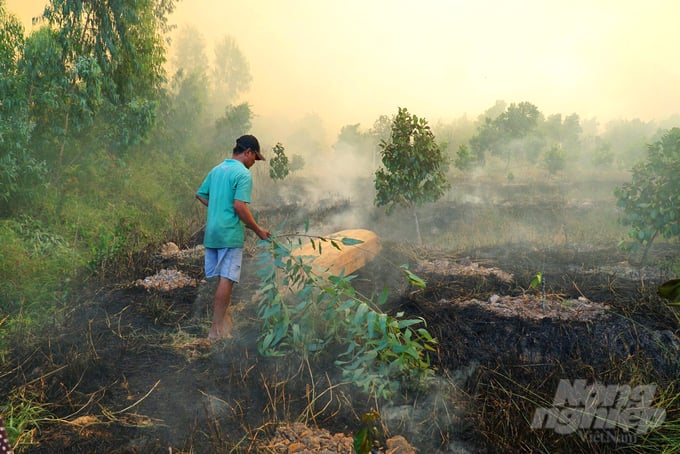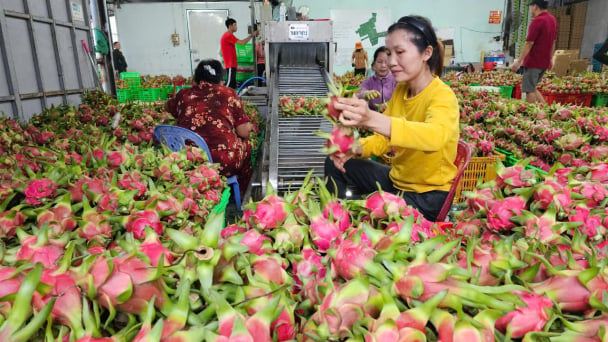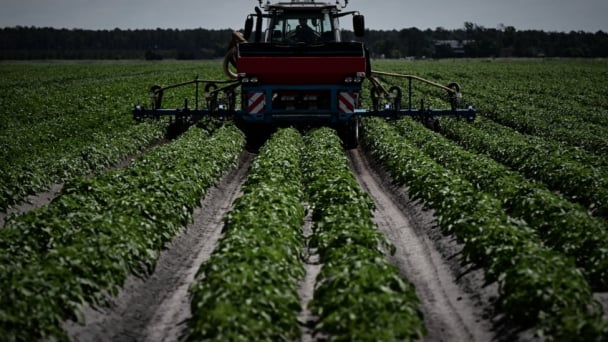June 17, 2025 | 16:45 GMT +7
June 17, 2025 | 16:45 GMT +7
Hotline: 0913.378.918
June 17, 2025 | 16:45 GMT +7
Hotline: 0913.378.918

The forest fire originated in the wetland habitat reserve area, which is home to rare bird species, located in sub-zone A1 of Tram Chim National Park, approximately 300 meters from Provincial Road 843. Photo: Le Hoang Vu.
According to initial reports, the forest fire originated in the wetland habitat reserve area, which is home to rare bird species, located in sub-zone A1 of Tram Chim National Park, approximately 300 meters from Provincial Road 843.
When the fire broke out in the A1 forest area, it created a dense smoke plume measuring several hundreds of meters in height. The smoke obscured visibility for approximately 1 kilometer on the Provincial Road 843. This road, a critical transportation route connecting Tam Nong, Tan Hong, and Hong Ngu districts to Hong Ngu city and Vietnam's border with Cambodia, experienced localized traffic congestion as a result.
As vehicles traveled through this stretch, the smoke and ash significantly reduced visibility, forcing their drivers to stop or decelerate.

Local authorities are currently focused on extinguishing the fire; and preventing the fire from spreading to the remaining Melaleuca forest area. Photo: Le Hoang Vu.
Le Thanh Son, Team Leader of the Resource Management Team under the Forest Protection Force at Tram Chim National Park, stated that various local agencies, the military, and the forest fire prevention force under the Dong Thap province's Sub-Department of Forest Protection have mobilized over 200 people to extinguish the fire in sub-zone A1.
Accordingly, the firefighting force has employed water to contain the fire, with a focus on establishing firebreaks and preventing the fire from spreading to the remaining Melaleuca forest area within the park. Local authorities have also formulated various contingency plans, including the potential evacuation of residents, especially children, from the affected area.
“The fire has spread rapidly due to the sunny midday weather and strong winds. However, local authorities are currently unable to gauge the extent of the damage and the total affected forest area,” reported Team Leader Le Thanh Son.

The forest fire at Tram Chim National Park has caused extensive damage to the surrounding fruit orchards owned by local residents. Photo: Le Hoang Vu.
Tram Chim National Park spans an area of over 7,300 hectares in Tam Nong district, Dong Thap province. After being designated as a national park in 1998, Tram Chim National Park served as a habitat for over 130 species of high-level flora, 231 species of waterfowl, over 100 species of fauna, and over 150 species of fish.
The park also plays a crucial role in conserving the critically endangered Sarus crane species. As a result of the declining Sarus crane population in Tram Chim National Park in recent years, Dong Thap province approved a conservation and development project for the Sarus crane at Tram Chim National Park for the years between 2022 and 2032. The project received an estimated total budget of 185 billion Vietnamese Dong.
According to researchers, the saurus crane is a rare and endangered species listed in both the Vietnamese and global red books. These birds are characterized by their red-headed and feathered necks, with gray patterns on their wings and tails. An adult crane stands between 1.5 and 1.8 meters tall, with a wingspan between 2.2 and 2.5 meters, and a weight between 8 and 10 kilograms. Cranes typically mate at three years old. Subsequently, they breed and nurture their offspring for a year before laying the next clutch.
Cranes often choose Tram Chim as their migration destination in Vietnam towards the end of the year and the beginning of the following year. The highest number of cranes recorded at the National Park was roughly 1,000 individuals. However, this figure has gradually declined over the years. According to statistics from Tram Chim National Park, only 21 cranes returned in 2015, followed by 14 in 2016, 9 in 2017, 11 in 2018, and 11 in 2019. Reportedly, no cranes returned in 2020, and only 3 returned in 2021 before disappearing for two more years.
The reason for this scarcity has been attributed to changes in the ecological environment within the park. Reduced flooding prevents the washing away of the surface vegetation, thereby reducing the local fish population, a primary food source for the cranes.
Translated by Nguyen Hai Long
![Turning wind and rain into action: [6] ‘Four on-the-spot’ disaster management software](https://t.ex-cdn.com/nongnghiepmoitruong.vn/608w/files/news/2025/06/14/z6705183772518_8e6a71d5e2d464e10197411eb1d14b51-nongnghiep-192556.jpg)
(VAN) By simply activating the scenario on the disaster management software, the relevant authorities immediately know how many households need to be evacuated, where to evacuate them to, and by what means of transportation…

(VAN) According to the Binh Thuan Department of Industry and Trade, in the first five months of 2025, Binh Thuan's dragon fruit export turnover increased by 20.65% compared to the same period last year.

(VAN) EU countries on Thursday gave final approval to new tariffs on fertilizer imports from Russia, a move aimed at cutting off revenue that could support Moscow’s war in Ukraine, despite concerns from European farmers.

(VAN) The working delegation from the Ministry of Agriculture and Environment conducted an important trip to the Netherlands to strengthen strategic partnerships and sustainable development in the agricultural sector.

(VAN) The letter ‘A Plea from the Ocean’ not only evokes emotion but also awakens the human conscience to the responsibility of protecting life on Earth.

(VAN) The Department of Agriculture in South Africa has announced the country’s first mass vaccination of poultry to prevent local birds from contracting avian influenza.

(VAN) Establishment of the Mekong Delta Regional Agricultural Linkage Center, aiming for a closed value chain, deep processing, trading platforms, and international market connectivity.